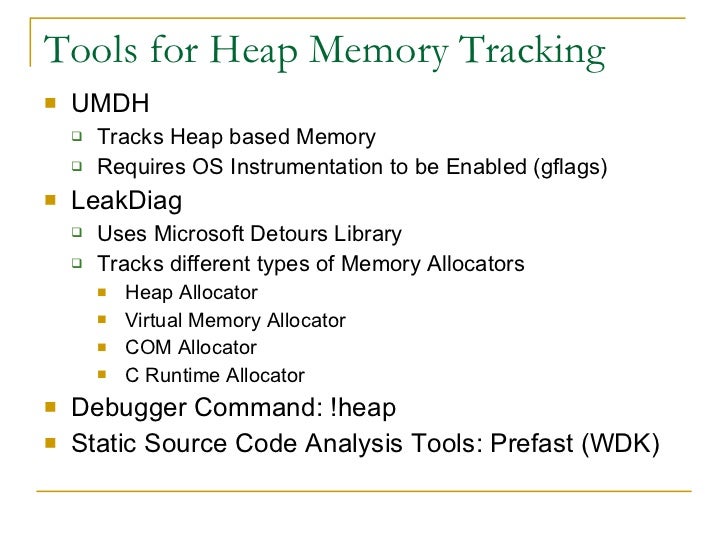Umdh Windows 7 Download


This is part 2 of an existing post. Previously, I showed how to use UMDH tool from Debugging Tools for Windows to generate and compare memory snapshots. Mar 16, 2017 Hi, We had been using UMDH tool to root out native memory leaks in Windows 7. But on Windows 10 this doesn't seem to work. When we execute the command umdh -p:2345 -f.
The user-mode dump heap (UMDH) utility works with the operating system to analyze Windows heap allocations for a specific process. UMDH locates which routine in a specific process is leaking memory. UMDH is included in Debugging Tools for Windows. For full details, see. Preparing to Use UMDH If you have not already determined which process is leaking memory, do that first.
For details, see. Contoh Program Oop Php Tutorial on this page. The most important data in the UMDH logs are the stack traces of the heap allocations. To determine whether a process is leaking heap memory, analyze these stack traces. Before using UMDH to display the stack trace data, you must use to configure your system properly. GFlags is included in Debugging Tools for Windows.
The following GFlags settings enable UMDH stack traces: • In the GFlags graphical interface, choose the Image File tab, type the process name (including the file name extension), press the TAB key, select Create user mode stack trace database, and then click Apply. Or, equivalently, use the following GFlags command line, where ImageName is the process name (including the file name extension): gflags /i ImageName +ust • By default, the amount of stack trace data that Windows gathers is limited to 32 MB on an x86 processor, and 64 MB on an x64 processor. Office 2003 Phone Activation Keygen Torrent. If you must increase the size of this database, choose the Image File tab in the GFlags graphical interface, type the process name, press the TAB key, check the Stack Backtrace (Megs) check box, type a value (in MB) in the associated text box, and then click Apply. Increase this database only when necessary, because it may deplete limited Windows resources.
When you no longer need the larger size, return this setting to its original value. • If you changed any flags on the System Registry tab, you must restart Windows to make these changes effective. If you changed any flags on the Image File tab, you must restart the process to make the changes effective. Changes to the Kernel Flags tab are effective immediately, but they are lost the next time Windows restarts. Before using UMDH, you must have access to the proper symbols for your application.
UMDH uses the symbol path specified by the environment variable _NT_SYMBOL_PATH. Set this variable equal to a path containing the symbols for your application. If you also include a path to Windows symbols, the analysis may be more complete. The syntax for this symbol path is the same as that used by the debugger; for details, see. For example, if the symbols for your application are located at C: MySymbols, and you want to use the public Microsoft symbol store for your Windows symbols, using C: MyCache as your downstream store, you would use the following command to set your symbol path: set _NT_SYMBOL_PATH=c: mysymbols;srv*c: mycache*In addition, to assure accurate results, you must disable BSTR caching.